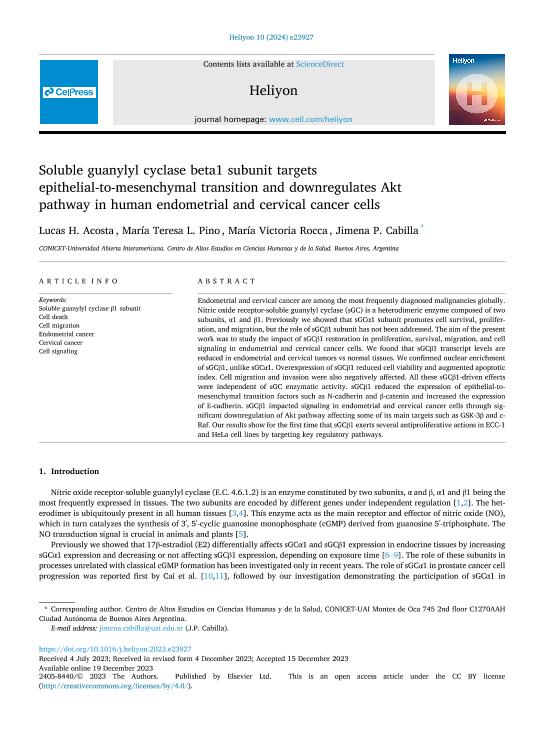Mostrar el registro sencillo del ítem
dc.contributor.author
Acosta, Lucas Hernan

dc.contributor.author
Pino, María Teresa Luján

dc.contributor.author
Rocca, María Victoria
dc.contributor.author
Cabilla, Jimena Paula

dc.date.available
2024-01-05T18:27:24Z
dc.date.issued
2023-12
dc.identifier.citation
Acosta, Lucas Hernan; Pino, María Teresa Luján; Rocca, María Victoria; Cabilla, Jimena Paula; Soluble guanylyl cyclase beta1 subunit targets epithelial-to-mesenchymal transition and downregulates Akt pathway in human endometrial and cervical cancer cells; Cell Press; Heliyon; 10; 1; 12-2023; 1-11
dc.identifier.uri
http://hdl.handle.net/11336/222665
dc.description.abstract
Endometrial and cervical cancer are among the most frequently diagnosed malignancies globally. Nitric oxide receptor-soluble guanylyl cyclase (sGC) is a heterodimeric enzyme composed of two subunits, α1 and β1. Previously we showed that sGCα1 subunit promotes cell survival, proliferation, and migration, but the role of sGCβ1 subunit has not been addressed. The aim of the present work was to study the impact of sGCβ1 restoration in proliferation, survival, migration, and cell signaling in endometrial and cervical cancer cells. We found that sGCβ1 transcript levels are reduced in endometrial and cervical tumors vs normal tissues. We confirmed nuclear enrichment of sGCβ1, unlike sGCα1. Overexpression of sGCβ1 reduced cell viability and augmented apoptotic index. Cell migration and invasion were also negatively affected. All these sGCβ1-driven effects were independent of sGC enzymatic activity. sGCβ1 reduced the expression of epithelial-to-mesenchymal transition factors such as N-cadherin and β-catenin and increased the expression of E-cadherin. sGCβ1 impacted signaling in endometrial and cervical cancer cells through significant downregulation of Akt pathway affecting some of its main targets such as GSK-3β and c-Raf. Our results show for the first time that sGCβ1 exerts several antiproliferative actions in ECC-1 and HeLa cell lines by targeting key regulatory pathways.
dc.format
application/pdf
dc.language.iso
eng
dc.publisher
Cell Press

dc.rights
info:eu-repo/semantics/openAccess
dc.rights.uri
https://creativecommons.org/licenses/by/2.5/ar/
dc.subject
Soluble guanylyl cyclase β1 subunit
dc.subject
Cell death
dc.subject
Cell migration
dc.subject
Endometrial cancer
dc.subject
Cervical cancer
dc.subject
Cell signaling
dc.subject.classification
Otras Medicina Básica

dc.subject.classification
Medicina Básica

dc.subject.classification
CIENCIAS MÉDICAS Y DE LA SALUD

dc.title
Soluble guanylyl cyclase beta1 subunit targets epithelial-to-mesenchymal transition and downregulates Akt pathway in human endometrial and cervical cancer cells
dc.type
info:eu-repo/semantics/article
dc.type
info:ar-repo/semantics/artículo
dc.type
info:eu-repo/semantics/publishedVersion
dc.date.updated
2024-01-05T11:41:37Z
dc.identifier.eissn
2405-8440
dc.journal.volume
10
dc.journal.number
1
dc.journal.pagination
1-11
dc.journal.pais
Estados Unidos

dc.journal.ciudad
Cambridge
dc.description.fil
Fil: Acosta, Lucas Hernan. Consejo Nacional de Investigaciones Científicas y Técnicas; Argentina. Universidad Abierta Interamericana. Facultad de Medicina. Centro de Altos Estudios en Ciencias de la Salud; Argentina
dc.description.fil
Fil: Pino, María Teresa Luján. Consejo Nacional de Investigaciones Científicas y Técnicas; Argentina. Universidad Abierta Interamericana. Facultad de Medicina. Centro de Altos Estudios en Ciencias de la Salud; Argentina
dc.description.fil
Fil: Rocca, María Victoria. Universidad Abierta Interamericana. Facultad de Medicina. Centro de Altos Estudios en Ciencias de la Salud; Argentina
dc.description.fil
Fil: Cabilla, Jimena Paula. Consejo Nacional de Investigaciones Científicas y Técnicas; Argentina. Universidad Abierta Interamericana. Facultad de Medicina. Centro de Altos Estudios en Ciencias de la Salud; Argentina
dc.journal.title
Heliyon
dc.relation.alternativeid
info:eu-repo/semantics/altIdentifier/url/https://www.sciencedirect.com/science/article/pii/S2405844023111352
dc.relation.alternativeid
info:eu-repo/semantics/altIdentifier/doi/https://doi.org/10.1016/j.heliyon.2023.e23927
Archivos asociados
